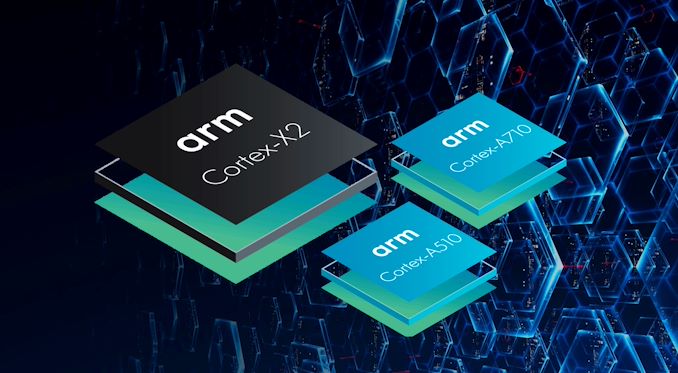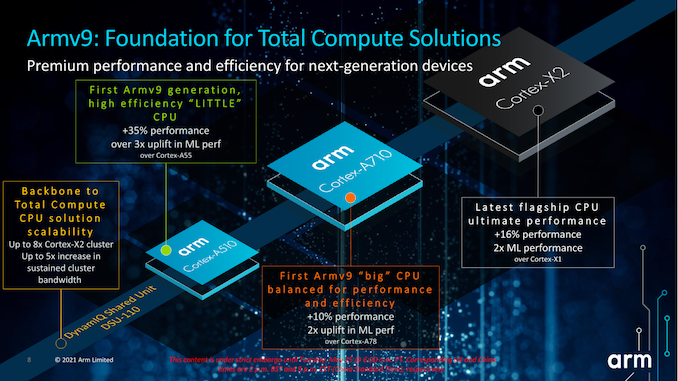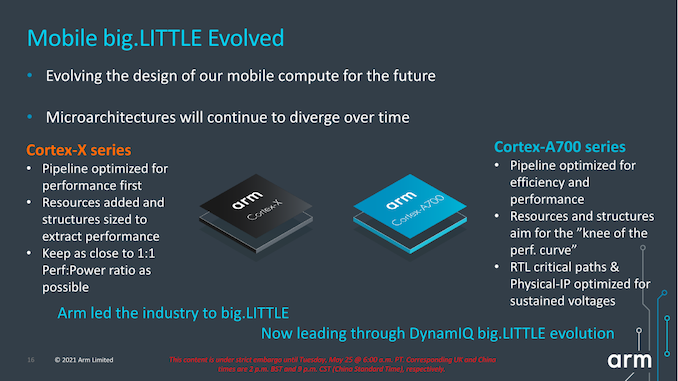Arm Announces Mobile Armv9 CPU Microarchitectures: Cortex-X2, Cortex-A710 & Cortex-A510
by Andrei Frumusanu on May 25, 2021 9:00 AM EST- Posted in
- SoCs
- CPUs
- Arm
- Smartphones
- Mobile
- Cortex
- ARMv9
- Cortex-X2
- Cortex-A710
- Cortex-A510

It’s that time of the year again, and after last month’s unveiling of Arm’s newest infrastructure Neoverse V1 and Neoverse N2 CPU IPs, it’s now time to cover the client and mobile side of things. This year, things Arm is shaking things up quite a bit more than usual as we’re seeing three new generation microarchitectures for mobile and client: The flagship Cortex-X2 core, a new A78 successor in the form of the Cortex-A710, and for the first time in years, a brand-new little core with the new Cortex-A510. The three new CPUs form a new trio of Armv9 compatible designs that aim to mark a larger architectural/ISA shift that comes very seldomly in the industry.
Alongside the new CPU cores, we’re also seeing a new L3 and cluster design with the DSU-110, and Arm is also making a big upgrade in its interconnect IP with the new cache coherent CI-700 mesh network and NI-700 network-on-chip IPs.
The Cortex-X2, A710 and A510 follow up on last year's X1, A78 and A55. For the new Cortex-X2 and A710 in particular, these are direct microarchitectural successors to their predecessors. These parts, while iterating on generational improvements in IPC and efficiency, also incorporate brand-new architectural features in the form of Armv9 and new extensions such as SVE2.
The Cortex-A510, Arm's new little core, is a larger microarchitectural jump, as it represents a new clean-sheet CPU design from Arm’s Cambridge CPU design team. A510 brings large IPC improvements while still having a continued focus on power efficiency, and, perhaps most interestingly, retains its characteristic in-order microarchitectural.
An Armv9 CPU Family – AArch64 only for all practical purposes*
The new CPU family marks one of the largest architectural jumps we’ve had in years, as the company is now baselining all three new CPU IPs on Armv9.0. We've extensively covered the details of the new Arm architecture back in late March. Cornerstone features of the new ISA include the new enrollment of prior optional/missing Armv8.2+ features that weren’t guaranteed in mobile and client designs (mostly due to the older A55 cores), and the introduction of new SVE2 SIMD and vector extensions.
One big change we’ve been expecting for quite some time now is that we’ll be seeing a deprecation of the 32-bit AArch32 execution mode in upcoming Arm Cortex-A mobile cores. The clock has been ticking for 32-bit apps ever since Google’s announced in 2019 that the Google Play store will require for 64-bit app uploads, and the company will stop serving 32-bit applications to 64-bit compatible devices later this summer
While Arm is declaring that shift to happen in 2023, for all intents and purposes it’s already happening next year for most global users. Both the Cortex-X2 flagship core and the Cortex-A510 little cores are AArch64-only microarchitectures that are no longer able to execute AArch32 code.
With that said, sharp readers will note that two out of three CPUs isn't a complete shift, and the reason for that is because the Cortex-A710 actually still supports AArch32. Arm states that the reason for this is primarily to meet the needs of the Chinese mobile market, which lacks the homogeneous ecosystem capabilities of the global Play Store markets, and Chinese vendors and their domestic app market require a little more time to facilitate the shift towards 64-bit only. This means we’ll have an odd scenario next year of having SoCs on which only the middle cores are able to execute 32-bit applications, with those apps being relegated to the middle A710 cores and missing out on the little A510 cores’ power efficiency or the X2 cores’ performance.
On the big core side, the new Cortex-X2 and Cortex-A710 are successors to the Cortex-X1 and Cortex-A78. Both designs are mostly designed by Arm’s Austin design team, and represent the 4th generation of this microarchitecture family, which had started off with the Cortex-A76 several years ago. These cores should be the last of this microarchitecture family before Arm hands things off to a completely new design with next year’s new Sophia cores.
In terms of design philosophy, the X2 and A710 generally keep the same overarching goals the X1 and A78 had defined: The X-series continues to focus on advancing performance by increasing microarchitectural structures and by Arm being willing to make compromises on power within reasonable limits. Meanwhile the A710 continues to focus on advancing performance and efficiency through smarter design and with a large focus on maximizing the power, performance, and area (PPA) balance of the IP.
One point Arm makes in the above slide is having optimized critical paths and physical design for sustained voltage operations – this is more of a goal the company is striving for in the next generations of “middle” cores rather than something that’s specifically reflected in the Cortex-A710.
This year, we are also finally seeing a new little core. We had covered the Cortex-A55 back in 2017, and since then we haven’t had seen any updates to Arm’s little cores, to the point of it being seen as large weakness of last few generations of mobile SoCs.
The new Cortex-A510 is a clean-sheet design from Arm’s Cambridge design team, leveraging a lot of the technologies that had been employed in the company’s larger cores, but implemented into a new in-order little microarchitecture. Yes – we’re still talking about an in-order core, and Arm still sees this to be the best choice in terms of extracting the best efficiency and “Days of use” of mobile devices.
Even though it’s a in-order core, Arm made a comparison that the new design is extremely similar to a flagship core of 2017 – namely the Cortex-A73, achieving very similar IPC and frequency capabilities whilst consuming a lot less power.
The new design also comes with a very interesting shared complex approach and shares the L2 and FP/SIMD pipelines with a second core, a design approach Arm calls “merged core” and undoubtedly will remind readers of AMD’s CMT approach in Bulldozer cores 10 years ago, even though there are quite important differences in the approaches.














181 Comments
View All Comments
ChrisGX - Thursday, May 27, 2021 - link
Yes, @melgross, @mattbe and @mode_13h are absolutely right. Apple has an architectural license from ARM, viz. a license for the ARM ISA rather than any physical IP. Not deterred by that some individuals commenting here seem to want to suggest that Apple has infringed on ARM's IP or somehow by nefarious means has acquired crucial information about proprietary tech found in ARM chips without stumping up the cash for it. These suggestions are pathetic. If a patent infringement is being alleged please tell us the patent number so that we can determine for ourselves whether there really has been a patent infringement. Or, is a criminal conspiracy with other parties to steal trade secrets from ARM being asserted? There is an obvious problem with that idea. Does anyone seriously suppose that ARM would fail to have Apple before a court demanding a huge settlement for theft of trade secrets, if it had any reason to think that Apple had been engaged in such an exercise? Uninformed individuals are just making up things that chime with their sense of how things must be. Hmm...here's a thought. If you know so little about a topic that you wouldn't be willing to stake your reputation on it or swear to in a court, say, then perhaps saying nothing on the topic would be a better choice than pretending to possess knowledge that you so obviously don't possess.mode_13h - Saturday, May 29, 2021 - link
> Uninformed individuals are just making up things that chime with> their sense of how things must be.
Welcome to the world of internet comment forums.
> If you know so little about a topic that you wouldn't be willing to stake your reputation on it
We don't do "reputation". Everybody is on equal footing, here. Just challenge them with facts, references, and sound logic.
jeremyshaw - Tuesday, May 25, 2021 - link
Thanks SarahKerrigan, igor velky. I was mostly thinking of configurations we didn't commonly see. We have seen 4xLITTLE, 2xbig.4xLITTLE, etc even the 8xA78C. The slides on page 5 cover setups we have seen before. Mostly curious if the fabric is tied to specific configs like was implied at the 8xA78C launch, or if it's flexible enough to have, say, two X2, two A710, four A510, or something like one X2 with four A510 (like Intel's Lakefield), etc. IMO, there are a lot of embedded controllers that don't need a lot of CPU throughput, but can benefit from one faster core for UI.Kangal - Saturday, May 29, 2021 - link
I'm more interested in seeing a 3+5 design.The "Large Cores" just aren't good on a phone, a tablet maybe, not on a phone. We're already getting throttling on the "Medium Cores" (eg Cortex A78/A710). And most tasks on Android are handled great in Dualcore mode, and very few in Quad-core mode, when looking at the schedulers. So Three Medium Cores will offer 95% of the performance of your regular flagship processor. Extending the Small Cores to a group of five, also can help efficiency by having more performance in the lower zone, reducing the amount of times the large cores need to be stressed.
However, with what was announced today, we can actually expect a REDUCTION in 2022 ARM processors compared to 2021 ARM processors. I mean we're talking about 10% gains in X2, 10% gains in A710, and 1% gains in A510, when compared to a design that should be on a better node with better cache. That's not guaranteed with the continuing Chip Shortage. IN FACT most chipmakers are willing to "cheap out" and simply use the marketing of "running on ARMv9" to justify the higher cost and lower performance.
They stuffed up with the naming scheme btw. And they really stuffed up by not removing 32-bit support completely. And they stuffed up with not doing a blank-sheet approach, for a revolutionary ARMv9 design. We're going to see the smallest gains in Android Phones, just like it happened when people were comparing the QSD 800/801/805 to the QSD 808/810 (Cortex A57) back in 2015. Which hopefully means ARMs other divisions in UK/France can pick the slack and come with a proper successor. This would be the Cortex A72 to their Cortex A57, a la, 2022 A710 versus the 2023 A730. Though I doubt the little cores will get any improvement besides a 10% bump due to the node lithography improvements.
psychobriggsy - Monday, June 21, 2021 - link
Theoretically this should support 16 A510s (8 clusters), as each cluster shares a port on the interconnect.We may see 2X 4B 4L configurations (10 cores) one day, but in the main I guess we're stuck with 1X 3B 4L (8L?) options. I see budget chips using 4L+4L (wider FP on some).
Wonder if there's room for an A310 chip (4 int cores per cluster, 1 shared FP, 2-wide).
docola - Tuesday, May 25, 2021 - link
does the shift to 64 bit cpus and apps mean that todays phone will startbecoming obsolete starting next year?
iphonebestgamephone - Tuesday, May 25, 2021 - link
If you are on a 32 bit phone yeahdocola - Tuesday, May 25, 2021 - link
fun... so this means i shouldnt buy an expensive phone for another 1 or 2 years,because this is gonna be one of those rare REAL shift in tech... sigh....
supdawgwtfd - Tuesday, May 25, 2021 - link
Current phones support 64bit instructions...No need to delay.
docola - Tuesday, May 25, 2021 - link
great thanks! i know i sound ignorant in here oh well